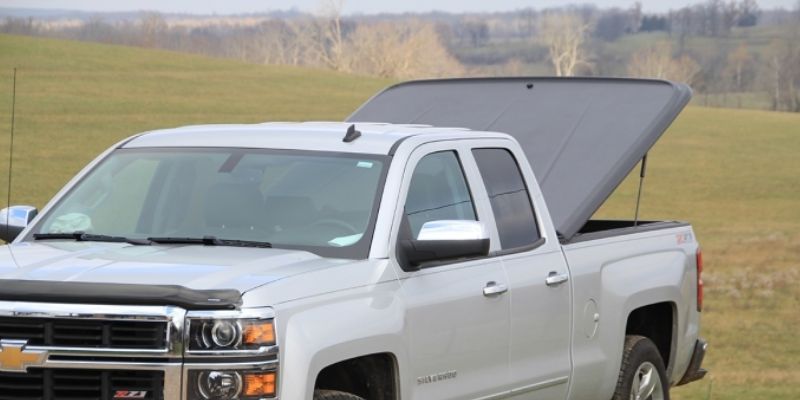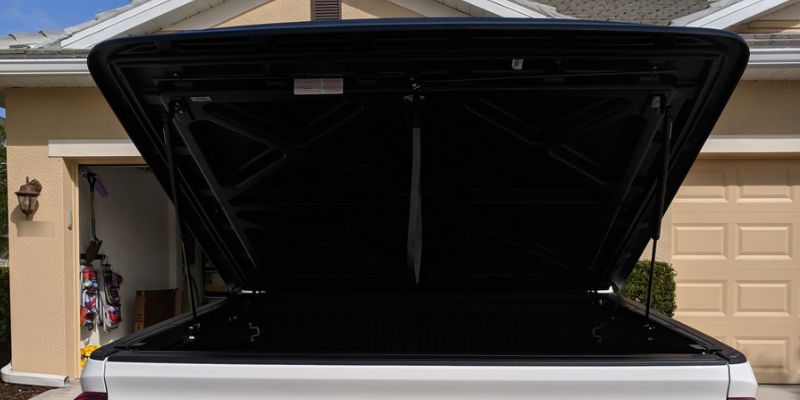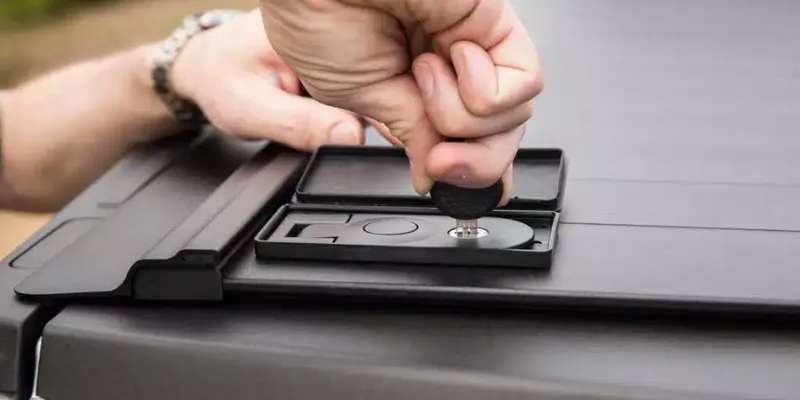The UnderCover SE tonneau cover, while popular among truck owners, presents several notable challenges that can impact its performance and longevity.
Users frequently encounter structural integrity issues, weather-related complications, and security vulnerabilities that require careful attention.
Understanding these common problems helps owners implement preventive measures and maintain their investment effectively.
The following analysis examines the most significant issues affecting this widely-used truck accessory and provides essential insights for current and prospective owners.
Hinge Failure and Cracking Issues

A significant number of UnderCover SE tonneau cover owners report hinge-related failures approximately two years after installation.
These common issues manifest through structural cracking at critical hinge locations, compromising the cover’s durability and operational integrity.
The deterioration leads to unwanted shifting during vehicle operation, necessitating frequent readjustment to maintain proper positioning.
The hinge failure presents additional complications beyond functionality concerns.
As the cover shifts, it can cause paint damage to the truck box through continuous friction.
Despite being marketed for long-term durability, these structural deficiencies often emerge under normal driving conditions on paved surfaces.
Vehicle owners face further challenges when seeking solutions, as replacement parts for damaged hinges are typically scarce.
Furthermore, warranty coverage may be denied for hinge-related issues if dealer installation was performed.
Water Leakage Around Lock Mechanism
Beyond structural hinge concerns, the UnderCover SE’s lock mechanism presents notable water infiltration vulnerabilities.
The primary issue stems from a deteriorating rubber seal surrounding the lockset, often compromised by extended sun exposure.
While some users attempt silicone applications as a remedy, this solution proves ineffective, breaking down during lock operation.
Critical to preventing water leakage is the precise installation and alignment of the rubber flap seal.
Post-installation hose testing can reveal potential infiltration points around the lock mechanism before significant usage.
The seal ring’s durability remains a persistent concern, as wear and tear progressively compromises its water-resistant properties.
To maintain peak performance, owners should conduct regular inspections of the seal assembly and implement timely replacements when deterioration becomes evident.
Paint Damage From Shifting Cover

Structural inconsistencies in the UnderCover SE tonneau cover manifest through lateral shifting during vehicle operation, resulting in progressive paint degradation on the truck box surfaces.
This deterioration stems from repeated contact between the shifting cover and the vehicle’s finish, necessitating frequent readjusting of the cover position.
Reports indicate compromised durability after two years of use, with broken hinges exacerbating the stability issues.
The observed cracking at hinge locations compounds the problem, leading to increased movement and subsequent paint damage.
Even when operated primarily on paved roads, the Undercover SE’s tendency to shift poses a significant risk to the truck box’s paintwork.
These ongoing issues often culminate in costly paint repairs, highlighting a critical flaw in the cover’s design and mounting system.
Installation and Fit Complications
While paint damage concerns highlight operational issues, installation challenges present their own set of technical complexities with the UnderCover SE tonneau cover.
Despite the manufacturer’s 45-minute installation estimate, users frequently encounter complications that demand careful attention and adjustments.
Common fit issues arise from existing plastic rivets interfering with the bulkhead extender, requiring strategic modifications.
The mounting brackets can create clearance issues with trunk lid operation, necessitating precise adjustments to prevent rubbing.
While the lightweight 58-pound design facilitates self-installation, proper sealing at rail joints remains critical for effective waterproofing.
Some users opt for DIY installation over professional services to maintain control over these technical nuances.
Additional sealant application at critical junctions often proves necessary to achieve ideal water resistance and secure fitment.
Warranty Coverage Disputes

How effectively UnderCover manages warranty claims emerges as a significant concern for SE tonneau cover owners.
The company’s three-year warranty policy becomes particularly contentious when installation is performed by dealers rather than owners, often resulting in disputed coverage claims.
Customer service interactions have proven problematic, especially regarding hinge failures and warranty disputes.
The company’s stance on installation-related issues has led to numerous denied claims, fostering negative perceptions among users.
Owners face additional challenges when seeking replacement parts, as the Undercover website lacks clear information about component compatibility and availability.
These warranty coverage complications have prompted many customers to explore alternative options from competing manufacturers, highlighting the impact of warranty disputes on brand loyalty and customer retention in the tonneau cover market.
Seal Ring Deterioration
Beyond warranty concerns, the seal ring deterioration in UnderCover SE tonneau covers presents a significant design vulnerability.
The black rubber seal ring surrounding the lockset area frequently experiences cracking and degradation, primarily due to prolonged environmental factors, particularly sun exposure.
This deterioration directly compromises the cover’s waterproof capabilities, with users reporting persistent leaks around the lockset area.
While temporary fixes like silicone application provide short-term relief, these solutions often fail during lock operation.
The limited availability of quality components for replacement further compounds the issue, forcing owners to explore alternative sealing methods.
The recurring nature of this problem highlights a critical need for more durable materials in the seal ring construction to guarantee long-term protection against environmental factors and maintain the cover’s integrity.
Trunk Lid Clearance Problems

A significant number of UnderCover SE owners encounter trunk lid clearance complications stemming from the cover’s mounting bracket configuration.
The mounting brackets frequently create obstruction points that prevent the trunk lid from opening fully, while the installation of plastic rivets compounds these clearance issues.
Users report consistent problems with the trunk lid rubbing against the cover during operation, potentially leading to long-term damage of both components.
Community feedback emphasizes that achieving proper fit requires careful attention during the initial installation process, often necessitating precise adjustments to the mounting brackets.
These modifications are essential for maintaining unrestricted trunk movement and preventing interference between the cover and lid components.
The recurring nature of these clearance issues suggests a design limitation that requires proactive management during setup and maintenance.
Weather-Related Performance Issues
While proper clearance represents a primary concern for UnderCover SE owners, weather-related performance issues present distinct operational challenges that affect the cover’s protective capabilities.
The most significant problem involves water leakage around the lockset area, primarily due to deteriorating rubber seals exposed to harsh weather conditions.
Proper seal placement and installation adjustments are critical factors in maintaining effective waterproofing.
Users have identified that misalignment of the cover can compromise its water-resistant properties, though the system demonstrates adequate protection when correctly sealed.
Strategic modifications, such as reducing the rear gap, have proven successful in enhancing water intrusion prevention.
However, the long-term durability of the rubber seals remains a concern, as continuous exposure to varying weather conditions can lead to cracking and decreased effectiveness over time.
Security Lock Malfunctions

Security lock malfunctions represent a significant concern for UnderCover SE owners, often manifesting through compromised locking mechanisms and deteriorating seal integrity.
The primary issues stem from wear and tear on critical components, particularly affecting the locking mechanism’s reliability and operational effectiveness.
A common problem involves the degradation of the rubber seal surrounding the lockset, which can crack and deteriorate over time, potentially leading to leaks and compromised security.
Installation misalignment further compounds these issues, creating additional stress on the locking components.
To maintain peak security performance, regular inspection and maintenance of the lock assembly are essential.
When malfunctions occur, owners should promptly engage with customer support to explore warranty coverage and obtain necessary replacement parts, ensuring their UnderCover SE maintains its intended security features.
Mounting Bracket Wear and Tear
Mounting bracket deterioration represents one of the most critical maintenance concerns for UnderCover SE owners, particularly affecting the tonneau cover’s stability and alignment during vehicle operation.
The wear and tear on mounting brackets manifests through several key issues.
Original plastic rivets often prove inadequate, necessitating replacement with more robust bolts to prevent shifting during travel.
Regular inspection reveals potential friction points where brackets can rub against the truck bed, causing damage over time.
These alignment problems frequently result in leaks and compromised performance.
To maintain ideal stability, owners should conduct systematic checks of mounting bracket conditions and make necessary adjustments.
Early detection of bracket wear enables preventive maintenance, helping preserve both the tonneau cover’s functionality and the truck bed’s integrity.
Professional installation modifications may be required to achieve proper fitment and long-term reliability.
FAQs
What Are the Disadvantages of a Tonneau Cover?
Tonneau covers present challenges including water leakage issues, installation difficulties, high costs, limited cargo access, reduced visibility, increased vehicle weight, questionable weather resistance, material durability concerns, and potential compatibility problems with specific truck models.
How Long Do Tonneau Covers Last?
Tonneau covers can last an incredible 2-10 years, with longevity factors including material durability and weather resistance. Regular maintenance greatly extends lifespan, while premium materials and proper installation guarantee maximum durability and protection.
Can a Tonneau Cover Be Repaired?
Tonneau covers can be repaired through various methods including DIY repairs for minor damages or professional services for complex issues. Cost factors vary based on material durability, with replacement options available under warranty for qualifying damages.
Final Thoughts
Like a vigilant sentinel, the UnderCover SE tonneau cover demands systematic attention to prevent its array of potential vulnerabilities.
Through methodical inspection protocols and strategic preventive maintenance, owners can fortify against structural failures, water infiltration, and operational degradation.
Implementation of proper installation procedures and regular monitoring of critical components serves as the cornerstone of peak performance, ensuring the cover’s integrity remains uncompromised over its operational lifespan.
